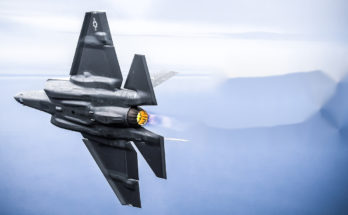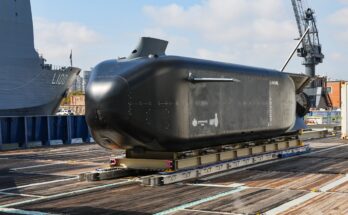by Derek Bisaccio, Military Markets Analyst, Forecast International.
“The Federation preserves our identity and enhances our capabilities. It is a strong shield for protecting the security and stability of the Arabian Gulf Region.” – Sheikh Khalifa bin Zayed al-Nahyan, President of the United Arab Emirates and Emir of Abu Dhabi
Amid the instability in the Middle East that followed the 2010 and 2011 protest movements, as well as a perceived vacuum as the United States asserts a desire to extricate itself from Middle Eastern conflicts, the United Arab Emirates (UAE) has seen a growing need to put its military to use securing regional interests.
Having participated in the Gulf War to oust the Iraqi military from Kuwait, as well as in deployments to Afghanistan and against the Islamic State, UAE forces have gained experience in supporting military operations.
Increasingly, however, the UAE, dubbed “Little Sparta” by U.S. Secretary of Defense James Mattis,[i] has been taking on the lead role. Under the foreign policy vision of Abu Dhabi’s Crown Prince, Mohammed bin Zayed al-Nahyan, the UAE is expanding its presence in the Arabian Peninsula – through a joint military operation with Saudi Arabia –and in Africa.
In July 2015, soon after intervening in Yemen’s ongoing conflict as part of a Saudi-led coalition, Emirati Special Forces assisted pro-government fighters in Operation Golden Arrow, recapturing control of the city of Aden from rebel group Ansar Allah.[ii] Less than a year later, in April 2016, Emirati-backed forces drove al-Qaeda in the Arabian Peninsula (AQAP) out of Mukalla. Emirati troops continue to maintain bases in Yemen for dual purposes: to fight Ansar Allah, which is allegedly supported by Iran, and to conduct counterterror operations. Emirati and American Special Forces conducted a joint raid in early 2017 that targeted an AQAP cell in Yemen.
Off the Yemeni coast, the UAE has acknowledged that its military conducts “intensive” training on the island of Socotra. Emirati authorities confirmed in May 2017 that troops there train in such battle skills as weapons and first aid.[iii] The UAE may also be building a base on the island of Perim, located in the Bab al-Mandeb Strait.
An Emirati deployment to a commercial port in Eritrea supports the Yemeni operation. Likely beginning sometime in 2015, the UAE signed a lease allowing its Navy to operate out of Assab. Furthermore, the UAE is believed to have improved the infrastructure of a nearby airport, to which it deployed combat jets in October 2016.[iv] Adjacent to the Assab airbase, an Emirati firm is constructing what appears to be a dedicated naval base.
This year, the UAE inked an agreement with the self-declared republic of Somaliland for a military base in the port of Berbera. The deal was supported almost unanimously by the Somaliland Parliament.[v]
Farther afield, the UAE is believed to operate at al-Khadim air base in Libya. Satellite imagery of the air base has revealed AT-802U or IOMAX Archangel counterinsurgency aircraft as well as armed Wing Loong drones. These aircraft, believed to be Emirati, have supported Khalifa Haftar’s militia – the Libyan National Army – in its military campaigns.
With an increased profile, however, comes increased risk. This was illustrated by the deaths of over 50 Emirati soldiers in an Ansar Allah rocket attack in September 2015, the deadliest attack on the country’s military.[vi] Emirati naval vessel HSV-2 Swift suffered significant damage as well, after being hit by an Ansar Allah anti-shipping missile in the Bab al-Mandeb Strait off the coast of Yemen in October 2016.
There is also the risk of local blowback. Speaking to Defense News, a European Union official who declined to be named warned of the potential for “unintended consequences” in Emirati deployments to the Horn of Africa.[vii] To some extent, the UAE is already encountering friction with its deployments.
In a meeting with Crown Prince Mohammed bin Zayed in February 2017, Yemeni President Abd Rabbuh Mansour Hadi reportedly accused the UAE of acting “like an occupation power in Yemen rather than a force of liberation,” after the prince reminded President Hadi of the extent of the Emirati sacrifice to restore him to power.[viii] Several months later, President Hadi sacked the Emirati-backed governor of Aden, in a move that revealed schisms in the Saudi-led coalition. While the UAE strongly condemned the move, Riyadh’s stance was more muted.
Local residents of Socotra have been wary of the increasing presence of Emirati forces on the island. Somali officials have sought to convince Saudi Arabia to pressure the UAE into abandoning its plans for the construction of the Berbera base.[ix] Ethiopia, a rival to Eritrea, previously warned the UAE over its deployment to Assab. Addis Ababa opposes the planned base at Berbera, as does neighbor Djibouti.[x]
The EU official who spoke to Defense News cautioned that the UAE should move carefully given the risks, while adding “but with wisdom, it could work well.” Crucially, the UAE has not solely pursued military engagement, but has also promoted humanitarian causes and development with many of its neighbors.
The country’s foreign policy espouses the need to provide humanitarian aid for neighboring countries through development projects and relief aid. The UAE’s Foreign Ministry notes that “[this policy] is dictated by an Islamic belief that helping those in need is a primary duty; and second, that part of the country’s wealth from oil and gas should be devoted to assisting other countries and individuals that are less fortunate.”[xi]
Acting upon that policy, the Emirates Red Crescent provides continuous support for Aden and Hadramaut governorates in Yemen. Since a hurricane that battered Socotra in 2015, the UAE has provided extensive – and ongoing – humanitarian support to the island. In January 2017, the governor of Socotra hailed the Emirati efforts on the island in building a residential city.[xii] As part of its agreement with Somaliland, the UAE will provide $1 billion in funds supporting economic and social development projects. Total Emirati aid to other countries in 2016 was over $4 billion,[xiii] over half of which went to countries in Africa.
Despite the risks inherent in foreign deployments, the UAE is starting to see success in its operations throughout the military and political spheres. Libyan media noted that “thanks to international and Arab mediation,” LNA commander Haftar and the head of the United Nations-backed Government of National Accord, Fayez Serraj, agreed to meet in Abu Dhabi earlier in May to discuss a political solution for the crisis in Libya.[xiv] Maintaining and improving upon that success, however, will require the UAE to tread carefully as it further immerses itself in diverse regional conflicts.
The Forecast International International Military Markets series examines the military capabilities, equipment requirements, and force structures inventories of 140 countries, with corresponding coverage of the political and economic trends shaping the defense market outlook for individual countries and regions.

[i] Rajiv Chandrasekaran, “In the UAE, the United States has a quiet, potent ally nicknamed ‘Little Sparta,'” The Washington Post, November 8, 2014. http://www.washingtonpost.com/world/national-security/in-the-uae-the-united-states-has-a-quiet-potent-ally-nicknamed-little-sparta/2014/11/08/3fc6a50c-643a-11e4-836c-83bc4f26eb67_story.html
[ii] Michael Knights and Alexandre Mello, “The Saudi-UAE War Effort in Yemen (Part 1): Operation Golden Arrow in Aden,” The Washington Institute, August 10, 2015. http://www.washingtoninstitute.org/policy-analysis/view/the-saudi-uae-war-effort-in-yemen-part-1-operation-golden-arrow-in-aden
[iii] The New Arab, “UAE confirms military activities on Yemen’s Socotra island,” May 16, 2017. http://www.alaraby.co.uk/english/news/2017/5/16/uae-confirms-military-activities-on-yemens-socotra-island
[iv] Jeremy Binnie, “UAE deploys fast jets to Eritrea,” IHS Jane’s Defence Weekly, November 14, 2016. http://www.janes.com/article/65455/uae-deploys-fast-jets-to-eritrea
[v] BBC News, “Somaliland agrees to UAE military base in Berbera,” February 13, 2017. http://www.bbc.com/news/world-africa-38956093
[vi] The National, “45 UAE servicemen die in Yemen,” September 4, 2015. http://www.thenational.ae/uae/government/20150904/45-uae-servicemen-die-in-yemen
[vii] Tom Kington, “EU source: Emirates’ militarization of Gulf of Africa risks blowback,” Defense News, May 18, 2017. http://www.defensenews.com/articles/eu-source-emirates-militarization-of-gulf-of-africa-risks-blowback
[viii] Khalid al-Karimi, “UAE-Saudi differences risk boosting separatists in Yemen,” The New Arab, May 16, 2017. http://www.alaraby.co.uk/english/comment/2017/5/16/uae-saudi-differences-risk-boosting-separatists-in-yemen
[ix] Radio Dalsan, “Farmaajo Seeks Saudi Arabia Intervention in Controversial Berbera UAE Military Base,” February 24, 2017. http://radiodalsan.com/en/farmaajo-seeks-saudi-arabia-intervention-in-controversial-berbera-uae-military-base/
[x] Al-Arabiya, “Somaliland agrees to UAE military base in northern port,” February 12, 2017. http://english.alarabiya.net/en/News/gulf/2017/02/12/Somaliland-agrees-to-UAE-military-base-in-northern-port.html
[xi] United Arab Emirates Ministry of Foreign Affairs & International Cooperation, “UAE Foreign Policy,” accessed on May 19, 2017. http://mofa.gov.ae/EN/TheMinistry/Pages/UAE-Foreign-Policy.aspx
[xii] The National, “UAE hailed for building residential city in Socotra,” January 8, 2017. http://www.thenational.ae/uae/uae-hailed-for-building-residential-city-in-socotra
[xiii] Gulf News, “UAE ranked world’s top aid donor for third consecutive year,” April 11, 2017. http://gulfnews.com/news/uae/aid/uae-ranked-world-s-top-aid-donor-for-third-consecutive-year-1.2009870
[xiv] Al-Jazeera, “Fayez al-Sarraj meets Khalifa Haftar in UAE for talks,” May 2, 2017. http://www.aljazeera.com/news/2017/05/fayez-al-sarraj-meets-khalifa-haftar-uae-talks-170502140623464.html
For 50 years, Forecast International intelligence reports have been the aerospace and defense industry standard for accurate research, analysis, and projections. Our experienced analysts compile, evaluate, and present accurate data for decision makers. FI's market research reports offer concise analysis of individual programs and identify market opportunities. Each report includes a program overview, detailed statistics, recent developments and a competitive analysis, culminating in production forecasts spanning 10 or 15 years. Let our market intelligence reports be a key part of reducing uncertainties and mastering your specific market and its growth potential. Find out more at www.forecastinternational.com



